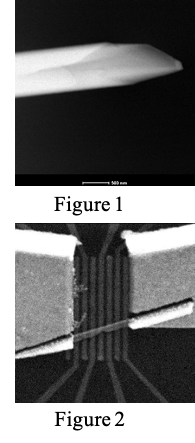Fabrication of Gate Defined Quantum Dots in Tellurium Nanowires
Student: Katie Welch
Major Professor: Dr. Hugh Churchill
Research Area(s):
Nanoscience & Engineering
Background/Relevance
- Tellurium is a crystalline element and at nano scales has a long chain structure lattice created from covalently bonded atoms to form helical chains. Tellurium nanostructures are expected to have significantly different properties from bulk tellurium due to unique helical crystal structure.
- The native oxide of tellurium TeO_2 is found commonly with the element when the element is heated in air.
Innovation
- Gate-based fabrication of tellurium quantum dots in order to study the quantum properties of tellurium.
- Fabrication leading to future applications of the element.
Approach
- View tellurium nanowires under transmission electron microscopy (TEM) in order to view crystal properties.
- Develop gate-based devices from tellurium nanowires in order to create quantum dots using physical transfer to gates followed by standard lithography techniques.
- Determine effectiveness of native oxide insulator in the development of the devices compared to synthesized insulator 〖Al〗_2 O_3.
- Test devices in dilution refrigerator for current flow through the quantum dots.
Key Results
-
Figure 1 shows TEM photograph of tellurium nanostructure. The growths suspected to have only nanowires had other structures such as nanotubes and rolled planes (pictured).
-
Optical viewing of wires proved to be unreliable, exemplified in Figure 2 of device 6. The wire is not uniform as expected.
-
The native oxide proved to be a problem rather than a solution in the fabrication of tellurium devices due to connectivity issues with gold contacts. However, 〖TeO〗_2 may have been an effective insulator between the wire and the gates.

Conclusions
- Tellurium growths of different nanostructures could be useful for future applications of quantum devices.
- The age of the wires may have affected the amount of 〖TeO〗_2 growth, leading it to be greater than expected and prevented devices from working.
- Useful fabrication procedures regarding tellurium nanowires were discovered that could aid future work with gate-based fabrication procedures.
- Wires need to be analyzed further to determine their nanostructure, thickness, and uniformity.
